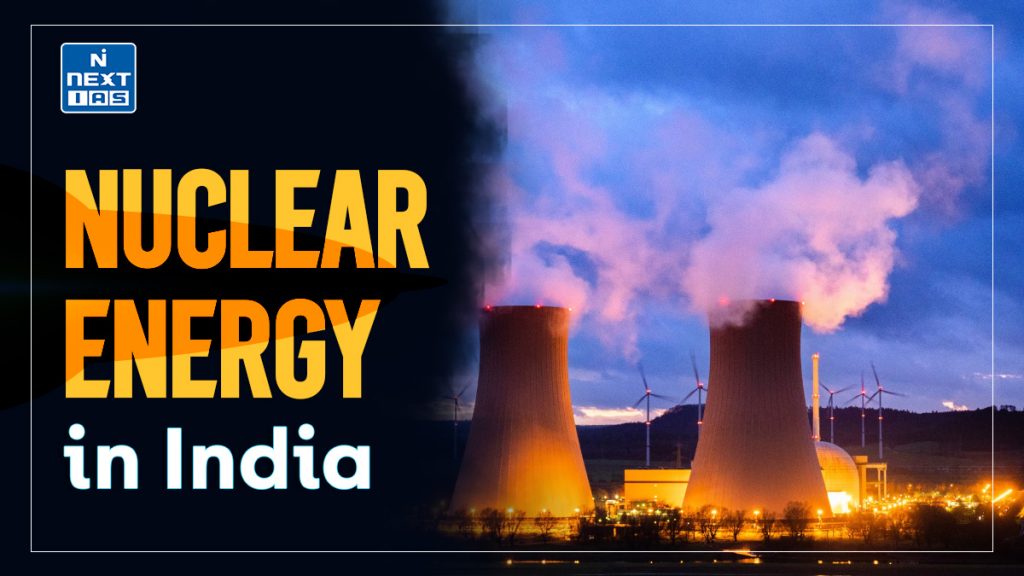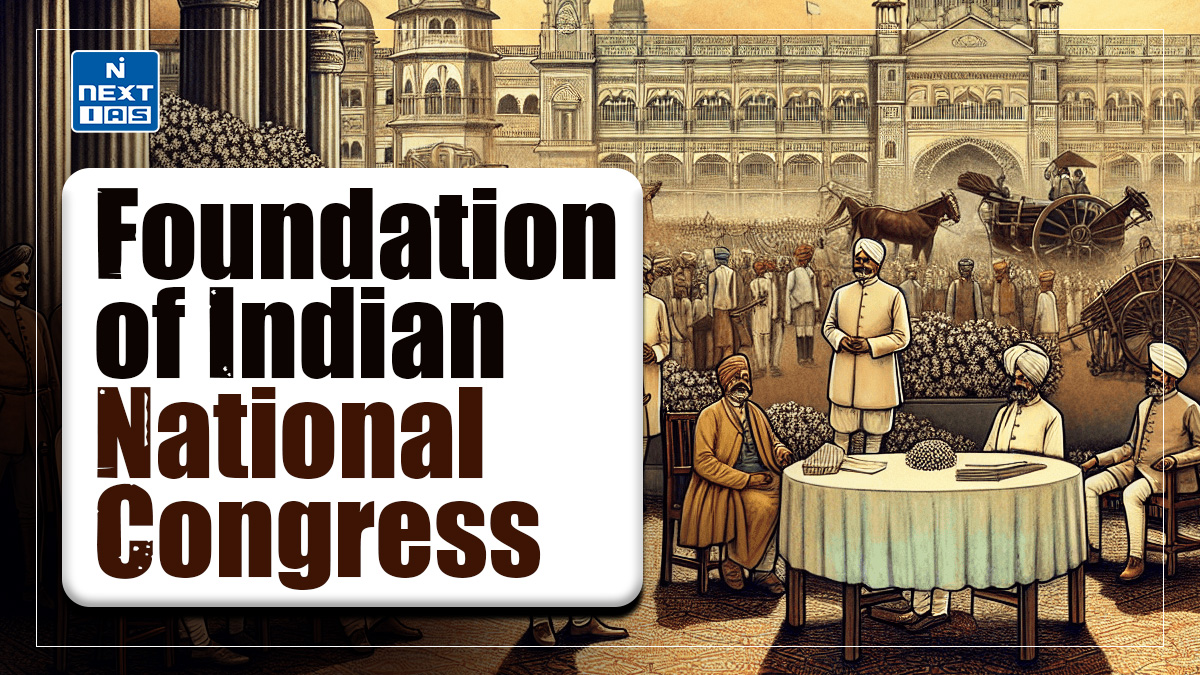
Nuclear energy plays a vital role in India’s energy strategy, addressing its growing power demands sustainably. Managed by the Department of Atomic Energy, India harnesses nuclear power through indigenous technologies and international collaboration. It supports energy security, reduces carbon emissions, and contributes to economic growth, aligning with the nation’s development goals.
About the Nuclear Energy In India
- Nuclear energy is a cornerstone of India’s strategy to meet its increasing energy demands while reducing dependence on fossil fuels. Governed by the Department of Atomic Energy (DAE), India’s nuclear program focuses on self-reliance, with indigenous technology complemented by international cooperation.
- As of now, India operates 22 nuclear reactors with a total installed capacity of over 7,480 MW, contributing around 3% to the nation’s electricity mix.
- India follows a unique three-stage nuclear power program designed to efficiently utilize its vast thorium reserves.
- The first stage involves using natural uranium in pressurized heavy water reactors (PHWRs), followed by the development of fast breeder reactors in the second stage.
- The final stage aims to exploit thorium in advanced reactors for sustainable energy production.
- Nuclear energy not only bolsters India’s energy security but also aligns with its commitments to combat climate change by offering a low-carbon and reliable power source for long-term growth.
Advantages of Nuclear Energy
Nuclear energy offers several significant advantages, including:
- Low Carbon Emissions: Nuclear power generates electricity with minimal greenhouse gas emissions, contributing to climate change mitigation efforts.
- High Energy Density: A small amount of nuclear fuel can produce a large amount of energy, making it highly efficient compared to fossil fuels.
- Reliable and Stable: Nuclear power plants provide a consistent and stable energy supply, as they can operate continuously for long periods (typically 18-24 months) before requiring refueling.
- Energy Security: Nuclear energy reduces dependence on imported fossil fuels, enhancing a nation’s energy security and reducing vulnerability to price fluctuations and supply disruptions.
- Base-load Power: Unlike renewable energy sources like solar and wind, which are intermittent, nuclear energy provides a steady and reliable base-load power supply.
- Long-term Potential: Advances in nuclear technology, such as thorium reactors and fusion energy, offer the potential for long-term, sustainable energy production.
What are the Challenges before India’s Nuclear Energy?
India’s nuclear energy sector faces several challenges, including:
- Safety Concerns: Public apprehension about nuclear accidents, such as the ones in Chernobyl and Fukushima, creates resistance to nuclear energy projects. Ensuring the safety of reactors and addressing these concerns through transparent safety measures remains a critical challenge.
- High Capital Costs: The construction of nuclear power plants involves significant upfront capital investment, often exceeding the costs of other energy sources like coal or renewables. These high costs can delay or hinder the development of nuclear energy infrastructure.
- Nuclear Waste Management: Managing radioactive waste is a major concern for India’s nuclear industry. Safe and long-term disposal solutions for high-level waste remain an unresolved issue, requiring technological advancements and public acceptance.
- Dependence on Imported Uranium: While India has made strides in developing nuclear fuel, the country still relies on imported uranium for its reactors, which raises concerns about supply security and geopolitical risks.
- Regulatory and Bureaucratic Delays: The approval process for new nuclear projects can be slow due to complex regulatory requirements, land acquisition issues, and environmental concerns. These delays hinder timely project implementation.
- Technological Limitations: While India is developing its indigenous nuclear technology, there is a need for further advancements in reactor designs, fuel cycles, and waste management techniques to make nuclear energy more sustainable and efficient in the long run.
- Public Opposition: Nuclear power has faced resistance from local communities, particularly near proposed plant sites. Concerns about land acquisition, displacement, and environmental impacts contribute to this opposition.
- International Challenges: India’s nuclear energy ambitions are constrained by its non-signatory status to the Nuclear Non-Proliferation Treaty (NPT), which has impacted its access to international nuclear fuel and technology. However, recent agreements like the Indo-US nuclear deal have helped alleviate some of these restrictions.
Addressing these challenges requires robust policy frameworks, technological advancements, and public engagement to ensure the sustainable growth of nuclear energy in India.
What is a National Strategy for a Rapid Scale-up of Nuclear Energy?
A national strategy for the rapid scale-up of nuclear energy in India should focus on several key areas to ensure its sustainable growth and integration into the country’s energy mix. Key components of such a strategy would include:
- Policy and Regulatory Support:
- Streamlining Approvals: Simplifying regulatory processes and accelerating the approval timelines for new nuclear plants, while ensuring high safety and environmental standards, will speed up the establishment of nuclear power stations.
- Supportive Legislation: Implementing clear and long-term policies that encourage investment in nuclear energy, including incentives for private sector participation, while ensuring the safety of communities and workers.
- Infrastructure Development:
- Expansion of Nuclear Plants: Expanding existing plants and building new reactors, especially in areas with established infrastructure, to significantly increase the capacity of nuclear power in the grid.
- Enhanced Transmission and Distribution: Strengthening grid infrastructure to accommodate additional nuclear-generated electricity and ensure efficient power distribution.
- Indigenous Technological Development:
- Fast Breeder Reactors and Thorium Utilization: Investing in advanced technologies, like fast breeder reactors (FBRs) and thorium-based reactors, to utilize India’s abundant thorium resources and extend the longevity and sustainability of nuclear power.
- Innovation in Reactor Designs: Promoting research into smaller, safer modular reactors (SMRs) and next-generation reactors to increase flexibility, cost-efficiency, and safety.
- Safety, Waste Management, and Public Engagement:
- World-Class Safety Standards: Ensuring adherence to the highest international safety protocols, regularly upgrading them, and fostering a safety culture at all levels of operation.
- Radioactive Waste Management: Developing safe, long-term solutions for the disposal and storage of nuclear waste, including reprocessing and recycling of spent fuel to minimize waste accumulation.
- Public Outreach and Education: Addressing public concerns and increasing awareness of nuclear energy’s benefits and safety through transparent communication and community engagement efforts.
Read our detailed article on Waste Management in India.
- International Cooperation and Technology Sharing:
- Collaborations with Global Nuclear Leaders: Strengthening partnerships with countries that have advanced nuclear technologies, such as the US, France, and Russia, to gain access to best practices, technology transfers, and uranium supplies.
- International Nuclear Agreements: Expanding cooperation through agreements like the Indo-US nuclear deal to ensure access to nuclear fuel and advanced technology while adhering to non-proliferation norms.
- Investment in Human Capital:
- Skilled Workforce Development: Developing a highly trained workforce, including scientists, engineers, and technicians, to manage and operate nuclear facilities. This would require increased investment in education and research in nuclear science and technology.
- Research and Development: Strengthening domestic research in nuclear energy to foster innovation, improve reactor efficiency, and reduce costs.
- Integration with Renewable Energy:
- Complementing Renewables: Using nuclear energy as a stable, base-load power source that complements intermittent renewable sources like solar and wind, ensuring grid reliability and reducing fossil fuel dependence.
- Hybrid Energy Systems: Developing hybrid energy systems where nuclear power is integrated with renewable energy solutions for greater flexibility and sustainability.
- Financial Investment and Public-Private Partnerships:
- Increased Funding: The government should allocate more funding for nuclear energy projects while encouraging private sector investment through public-private partnerships (PPP) and other financial instruments.
- Affordable Energy Solutions: Ensuring that nuclear energy remains economically viable by improving cost-efficiency, reducing plant construction time, and minimizing operational costs.
By combining these strategies, India can rapidly scale up its nuclear energy capacity, supporting its energy security goals, reducing carbon emissions, and ensuring sustainable growth for the future.
Way Forward
- The future of nuclear energy in India lies in expanding reactor capacity, adopting advanced technologies like thorium reactors, and enhancing safety measures. Collaboration with global partners for innovative solutions, along with efficient waste management, will drive sustainability.
- Increased investment and research will ensure nuclear power contributes significantly to India’s energy mix, supporting economic growth and climate goals.
Conclusion
Nuclear energy is essential for India’s sustainable growth, providing a reliable, low-carbon power source. With advancements in technology and a focus on thorium-based reactors, India aims to enhance energy security and contribute to climate change mitigation. Nuclear power plays a crucial role in meeting the nation’s future energy needs.
Frequently Asked Questions (FAQs)
What is nuclear energy?
Nuclear energy is the energy released during nuclear reactions, primarily through fission (splitting atomic nuclei) or fusion (combining nuclei). In nuclear power plants, fission of uranium or plutonium produces heat, generating steam to drive turbines and produce electricity. It’s a powerful, low-carbon energy source but involves waste and safety challenges.
What percentage of India’s energy is nuclear?
As of 2024, nuclear energy contributes approximately 3% to India’s total electricity generation. The country has an installed nuclear capacity of 7.48 GWe, which is set to increase to 13.08 GWe by 2029 with new reactor additions. While nuclear energy’s share in India’s overall energy mix remains modest, it is a critical component of India’s long-term strategy to achieve energy security and reduce carbon emissions.
Which state is the largest producer of nuclear energy in India?
Tamil Nadu is the largest producer of nuclear energy in India, hosting significant facilities like the Kudankulam Nuclear Power Plant, which has an operational capacity of 2,000 MW and is expanding further. The state contributes substantially to India’s nuclear energy production, aiding its overall energy mix.
Where is nuclear energy found in India?
In India, nuclear energy facilities are distributed across several states. Major power plants include Kudankulam in Tamil Nadu, Tarapur in Maharashtra, Kakrapar in Gujarat, Rawatbhata in Rajasthan, Narora in Uttar Pradesh, and Kalpakkam in Tamil Nadu. These plants use uranium or thorium to produce electricity.
Which is the biggest nuclear power plant in India?
The Kudankulam Nuclear Power Plant in Tamil Nadu is the largest in India. It has an installed capacity of 2,000 MW, generated by its two operational reactors of 1,000 MW each. Additional reactors under construction aim to further expand its capacity to 6,000 MW.
Which state of India has no nuclear power plant?
Several Indian states, such as Bihar, Odisha, West Bengal, and Kerala, currently do not have operational nuclear power plants. While some regions like West Bengal have proposed sites, active reactors have not been established there yet.
Is nuclear energy renewable?
Nuclear energy is not considered strictly renewable because it relies on finite resources like uranium and thorium, which must be mined and processed. However, it is often grouped with renewable sources in discussions on low-carbon energy due to its minimal greenhouse gas emissions during operation. Advanced technologies like breeder reactors and potential fusion energy could make nuclear energy more sustainable in the future.





